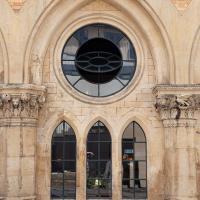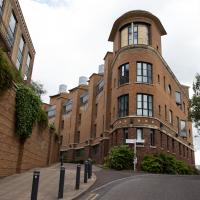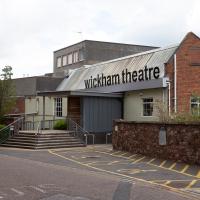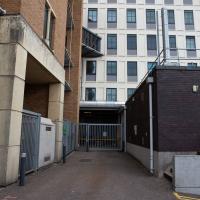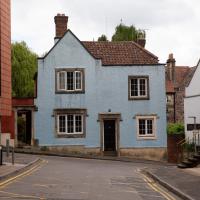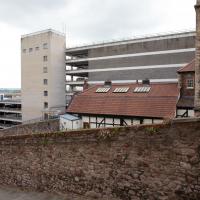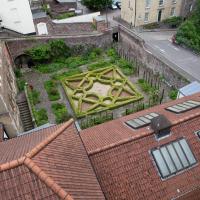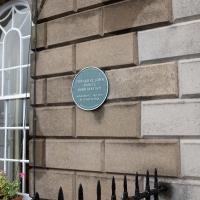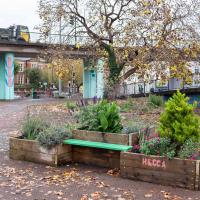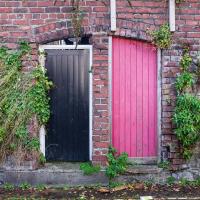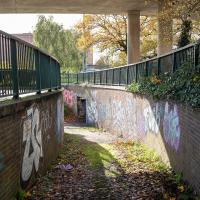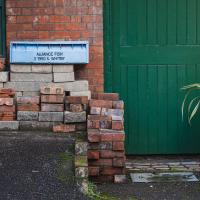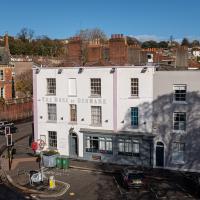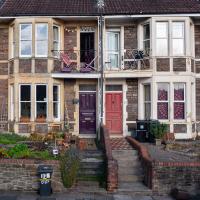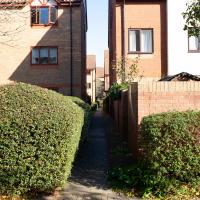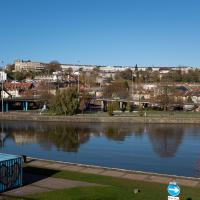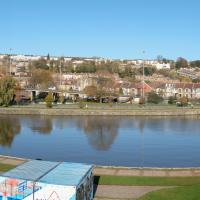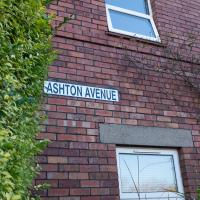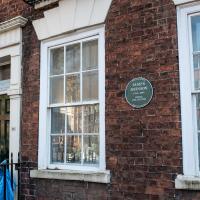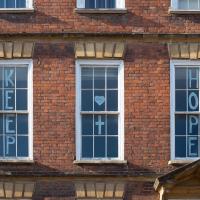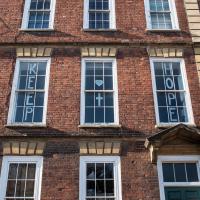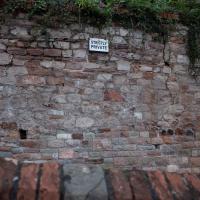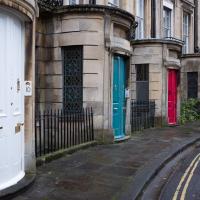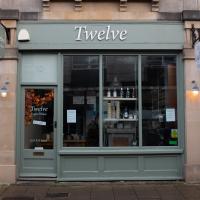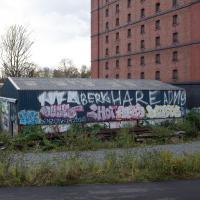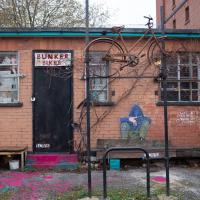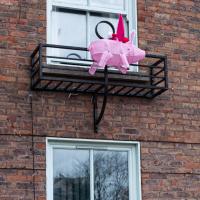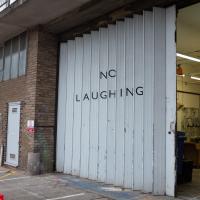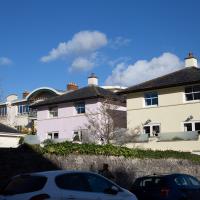Tagged: property
A Longer-than-it-looks Walk With Lisa
06 Jun 2021
The track on the map doesn't tell the whole story of this walk with Lisa around and about Clifton, Berkeley Square, Brandon Hill and the harbourside, because the batteries on my GPS ran out while we were on the roof of Trenchard Street car park, it seems. Oh well. I think I did most of the area I was interested in finishing off around the University; there were only a few new bits around Brandon Hill that won't be on the track, and I can easily do them again.
Still, technology woes aside it was a nice walk, albeit a bit warm for climbing all those hills, and sat on the harbourside watching the world go by for a while, too. It was good to see the Bristol Ferry Boats carrying people around again, especially.
...and on the same lamppost, some Kill The Bill literature. That's me: bringing you the social history that Google Street View can't.
Looked a bit to me like number 16 had tilted over to the left a bit since it was built...
"Identified as an Unlisted building of Merit in the St Michael's Hill and Christmas Steps Conservation Area Character Appraisal, January 2009.". It's certainly attractive, clearly old, and feels quite out of place dwarfed by the Uni's modern architecture. Interesting little house.
The "wigwam" is actually a structure along the lines of a Gloucestershire tithe barn.
The building I was interested in is the one with those skylights. It's the "wigwam" of an artists' collective that was until quite recently called the Bristol Savages and used native American imagery quite strongly in its branding, and also didn't let women in, apparently.
They were somewhat roasted for this behaviour and have now emerged as Bristol 1904 Arts instead.
I have no tomahawk to grind here; I was merely interested in a former member, Donald Hughes, who painted some interesting scenes of Bristol and whom I believe may have been a member of the Stella Matutina, a long-defunct secret society I'm interested in. (It's a long story.)
I was completely wrong in my guess about the little silver piple in the mid-distance; it's not the Airstream trailers on the roof of the boutique hotel in St Nick's; Lisa was right that it's too far to the left in this view. It is, in fact, the roof of Cabot Circus, much further away.
In my defence, it was harder to see with the naked eye, especially as my naked eyes don't work very well anyway...
The End of a Private Road
27 Oct 2020
One of the homes in Windsor Terrace went on the market for £2,000,000 a few years back. This is the closest I've been to it, right at the end of the private road. Presumably they're okay with people wandering down the road if there's a blue plaque to be seen at the far end?
Both the plaque to Edward St John Daniel and the other photo I took (in these early walks I was mostly walking, rather than mostly taking photographs) have interesting stories of a rise and fall associated with them in the first Google hits I found. Daniel was indeed the youngest recipient of the VC, but was stripped of the medal by Queen Victoria herself in 1861, following conviction for desertion and evading court martial. Lubetkin is probably most famous for designing the penguin pool at London Zoo, which was closed 17 years ago, after the micro-abrasions in the penguins' feet caused by the concrete led to them developing an infection with the charming name "bumblefoot".
Catherine Progress
29 Oct 2020
They're refurbishing (by which they seem to mean ripping almost completely apart and rebuilding) the Catherine in Underfall Yard at the moment. I like checking on the progress when I pass by the Patent Slip.
They've been trying to pretty it up, but it's a bit like putting a small elastoplast on a severed limb.
Local
03 Nov 2020
A very local exploration today, but there are still bits of the near field that I never need to walk down, so it didn't take me long to find somewhere I haven't been in a decade or more, the little enclave of smaller Victorian houses around Oldfield Road and Sandford Road. I'd really like to live in one of those houses, but I doubt I could afford it.
Scarborough and Whitby, right? Despite being a goth at heart, I've still never been to Whitby.
Baltic Wharf and Marina
04 Nov 2020
You never know what you'll find when you go for a walk in Bristol. This gorgeous Mustang was in the Marina car park. Nice. I also surprised myself by getting a good photo of The Hand (to give it its full title, Green Hand of a River God, by Vincent Woropay. Thanks, @mfimage!)
Very Local
06 Nov 2020
It's surprisingly easy to overlook the giant Wesleyan Grenville Chapel—now converted into flats—if you've lived here a while. Other sights that seem to slip from my memory include the modest Ashton Avenue, a tidy terrace of little houses on a road that presumably gave its name to the Ashton Avenue bridge.
I'm not sure I ever realised there was still and Ashton Avenue to go with Ashton Avenue Bridge.
"Johnson is the first recorded serious collector of Lyme Regis fossils, active there from the early 1790s, and particularly deserves to be remembered" -- https://www.geolsoc.org.uk/Geoscientist/Archive/December-2008/A-saw-for-a-jaw
Little Clifton Village Details
09 Nov 2020
I like The Paragon as a terrace, especially the bowed porches. On the other side of the road, a house attic has a stone lion surrounded by rocaille leaves, according to its listing.
I also love the detail of the arrows in the wrought iron of The Mall's balconies. Today I discovered Westfield place, a road I'd never encountered that runs up to the rear of the Coronation Tap. (It's a famous local cider pub, but I've only been in a couple of times. I'm more of a beer man.)
This leads up to the back of the Paragon. Maybe we'll take a look at the front instead, then...
There's a private garden; from Google Maps it looks like it's mostly around to the right of here, behind a wall. It abutts the back gardens of Prince's Buildings and Windsor Terrace, I think, so might even have a way out onto Prince's Lane, or did have at some point in the past, before everything got quite overgrown back there.
I do like the rebellious scruffy place in among the clean Georgian spledour. My friend Marie-Louise once told me she wanted to live here, I think just because it was obviously a rebel stronghold...
Plimsoll Bridge Swing
10 Nov 2020
I went to grab a coffee from Imagine That's little horsebox by the marina, completely forgetting that they don't open on Monday or Tuesday. On the plus side, on the way back I was in time to watch the Plimsoll Bridge swinging for a tidy little yacht.
Doors and walls, closed paths and chalk
11 Nov 2020
I'd love to walk the Chocolate Path again at some point, but it's been closed since it started falling into the river. Still, on this wander to get a coffee I walked down a road I'd not normally use and found a door dressed up as a wall and another door that had been bricked up for real. Odd.
I also found a lovely bit of art on one of the Cumberland Piazza pillars on my way home.
This place always seemed like an eccentric enterprise, but I never met the owner, so I don't know if he was an actual eccectric himself.
Clifton Village: Jesus and the Tympanum
12 Nov 2020
My goal is walk down every public road within a mile of me; sometimes it's not easy to tell what's public. I've passed the turning for Cornwallis Grove a thousand times, but never had a reason to venture down it, and although the street signs at the end seem to be council-deployed and I didn't spot any "private" signs, it's a gated road and definitely feels private.
Gathering all the white middle-class privilege I could muster, I wandered down and was rewarded with the sight of a Victorian pump, a statue of Jesus, and from the end of the road, a view of a private garden that once belonged to a private girls' school.
The Cornwallis House history page says:
In the early 20th century the house, together with Grove House, became a Catholic school, St Joseph’s High School for Girls.
The Congregation of La Retraite took over the school in 1924, with the nuns living in Grove House while the schoolrooms were
in Cornwallis House. The headmistress was Mother St Paul de la Croix (Sister Paula Yerby). By the 1970s La Retraite High
School had around 700 pupils.It closed in 1982 and the building was bought by Pearce Homes Ltd (now part of Crest Nicholson) who developed it into 21
flats. Grove House next door was bought by the Bristol Cancer Help Centre, and was later converted into flats in 2007.

